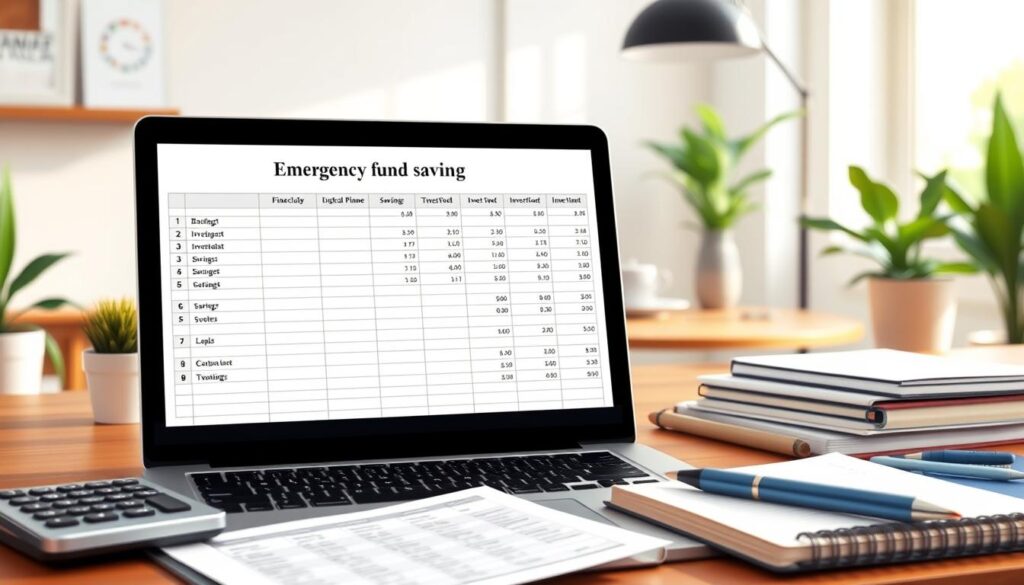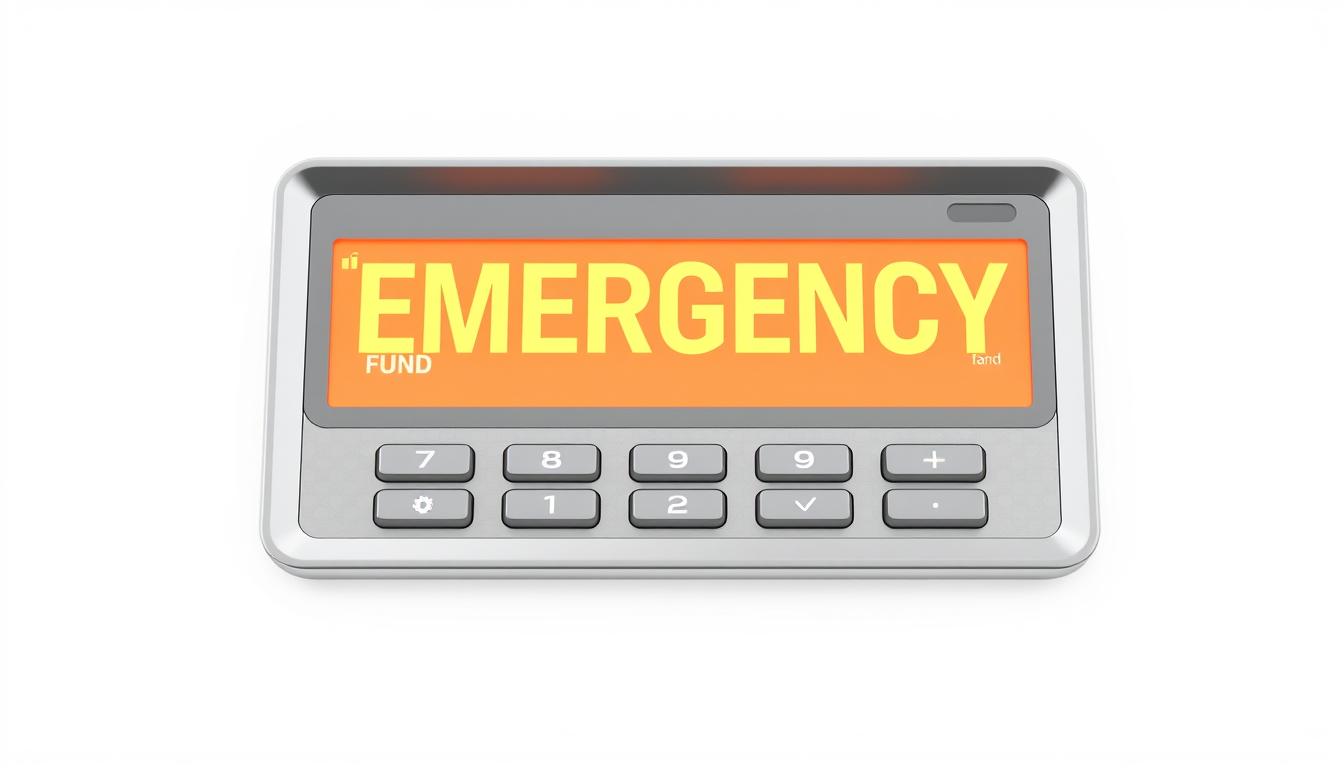Are you ready for life’s surprises? Things like a car breakdown, medical costs, or losing your job can happen anytime. Having money set aside can really help.
An emergency fund is more than just saving money. It’s a key part of planning your finances. But, how much should you save? That’s where a financial planning calculator helps.
For more tips on managing your money, check out www.fortydeal.com or email us at [email protected].
Table of Contents
Key Takeaways
- Understand the importance of having an emergency fund.
- Learn how to use an emergency fund calculator.
- Discover how to prepare for unexpected expenses.
- Explore the role of a financial planning calculator in your financial strategy.
- Find resources for further financial planning guidance.
What is an Emergency Fund?
An emergency fund is a financial safety net. It helps you deal with life’s unexpected turns. It’s a savings account for unexpected expenses, so you’re not caught off guard.
Definition and Purpose
An emergency fund is a savings account for unexpected costs. This includes car repairs, medical bills, or losing your job. Its main goal is to keep your finances stable and give you peace of mind.
Using a personal finance tool like an emergency fund calculator can guide you. It looks at your monthly spending and income to suggest how much to save.
Importance of Having an Emergency Fund
An emergency fund is key for financial stability. It prevents debt from unexpected expenses. It also ensures you can keep up with your financial duties even when faced with setbacks.
For example, if you lose your job, an emergency fund can cover your living costs. This gives you time and financial space to find a new job without stress.
| Expense Type | Average Cost | Emergency Fund Coverage |
|---|---|---|
| Medical Emergency | $1,000 | 3-6 months expenses |
| Car Repair | $500 | 1-3 months expenses |
| Job Loss | $0 (lost income) | 6-12 months expenses |
Common Misconceptions
Many think emergency funds are only for big crises. But they’re also for smaller surprises, like car repairs or broken appliances.
Another myth is that emergency funds are a one-time thing. In truth, keeping an emergency fund is an ongoing task. It needs regular contributions and updates based on your financial changes.
For personalized advice on building your emergency fund, email us at [email protected]. We’re ready to help you on your financial journey.
How to Use an Emergency Fund Calculator
To prepare for financial emergencies, you need to know how to use an emergency fund calculator. This tool helps you figure out how much to save. It ensures you’re ready for life’s surprises.
Step-by-Step Guide
Using an emergency fund calculator is easy. First, list your monthly expenses to see what you spend. Then, think about your job and how steady your income is. Lastly, consider your dependents and lifestyle to understand your financial health.
Here’s a simple guide:
- Enter your monthly expenses.
- Assess your job security and income stability.
- Consider the number of dependents you have.
- Adjust for any specific lifestyle choices or expenses.
Key Inputs for Effective Calculation
For a precise calculation, you’ll need to provide a few key inputs:
| Input | Description |
|---|---|
| Monthly Expenses | Total regular outgoings, including rent, utilities, and groceries. |
| Job Stability | Assess your employment security and income reliability. |
| Dependents | Number of people financially dependent on you. |
Tips for Accuracy
To get an accurate figure, be truthful about your expenses and financial duties. Use past emergency expenses to guide your inputs. For more tools and resources, visit www.fortydeal.com.
By following these steps and tips, you can use an emergency fund calculator well. This helps you plan your savings and improve your financial safety.
Determining Your Emergency Fund Needs

It’s important to know your monthly costs and how steady your income is. This helps figure out how much you need in an emergency fund. You need to look at your finances closely to be ready for surprises.
Assessing Your Monthly Expenses
To figure out your monthly costs, track your spending for a few months. This will give you a clear view.
Monthly costs include things you can’t skip, like:
- Rent or mortgage
- Utilities
- Groceries
- Transportation
- Minimum payments on debts
A personal finance tool can make this easier. It helps sort your expenses and find ways to save.
Evaluating Job Stability and Income
Your job’s stability and how much you make are key to figuring out your emergency fund needs.
Think about these points:
- Job security
- Industry stability
- Potential for overtime or bonuses
- Opportunities for career advancement
A financial planning calculator can show how these factors affect your emergency fund needs.
Considering Dependents and Lifestyle Choices
Having dependents and your lifestyle choices also impact your emergency fund needs.
For instance:
| Dependent/Lifestyle Factor | Impact on Emergency Fund |
|---|---|
| Having children | Increases the need for a larger emergency fund to cover childcare expenses |
| High-cost hobbies | May require a larger fund to maintain lifestyle during financial downturns |
For more info on financial planning and tools, email us at [email protected].
Types of Emergencies Covered by Your Fund
Life is full of surprises, and an emergency fund helps you prepare for them. It can cover sudden medical bills, job losses, or unexpected repairs like a leaky roof. Having a financial cushion can make a big difference.
Medical Emergencies
Medical emergencies can be costly and unpredictable. Accidents, sudden illnesses, or unexpected diagnoses can lead to significant medical expenses. Your emergency fund can help cover these costs, ensuring you receive the necessary care without financial strain.
For instance, a trip to the emergency room can result in bills totaling thousands of dollars. Having an emergency fund in place can alleviate the financial burden, allowing you to focus on recovery rather than worrying about the costs.
Job Loss or Reduced Income
Losing a job or experiencing a reduction in income can be a significant financial shock. Your emergency fund acts as a buffer, providing financial support during the period you are between jobs or while your income is reduced.
This fund can help you cover essential expenses such as rent, utilities, and groceries, giving you the time and peace of mind to find new employment or adjust to your new financial situation.
Unexpected Home Repairs
Homeownership comes with its own set of unexpected expenses. Leaky roofs, burst pipes, or failing appliances can require immediate attention and significant financial outlays.
An emergency fund can be used to cover these unexpected home repairs, ensuring your home remains safe and secure. This not only protects your investment but also prevents further damage that could arise from neglecting these repairs.
To better understand how different emergencies can impact your finances, consider the following table that outlines potential costs associated with various emergencies:
| Emergency Type | Potential Cost | Impact Without Emergency Fund |
|---|---|---|
| Medical Emergency | $5,000 – $10,000 | High financial strain, potential debt |
| Job Loss (3 months) | $10,000 – $20,000 | Severe financial strain, potential loss of home |
| Unexpected Home Repairs | $1,000 – $5,000 | Financial stress, potential for further damage |
For more information on managing your finances and creating an effective savings plan, visit www.fortydeal.com.
How Much to Save for Your Emergency Fund
An emergency fund is like a safety net for your money. But how much should you save? The amount needed varies based on your income, expenses, job security, and lifestyle.
Recommended Savings Targets
Financial advisors often suggest saving 3 to 6 months of living expenses. This helps cover emergencies like medical bills or car repairs. Start by adding up your monthly essential costs, like rent, utilities, groceries, and minimum debt payments.
For example, if your monthly costs are $3,000, aim to save $9,000 to $18,000. An emergency fund calculator can make this easier by helping you figure out your expenses and savings goal.
| Monthly Expenses | 3 Months Savings Target | 6 Months Savings Target |
|---|---|---|
| $2,000 | $6,000 | $12,000 |
| $3,000 | $9,000 | $18,000 |
| $4,000 | $12,000 | $24,000 |
Factors Influencing Your Savings Goal
Several things can affect how much you should save. For example, if you have a stable job, you might aim for the lower savings range. But if you’re self-employed or in a shaky industry, save more.
Consider your health, dependents, and any high-interest debt. For tailored advice, check out www.fortydeal.com.
« The key to financial freedom is not just about making more money, but also about managing what you have. »Unknown
Adjusting Goals as Life Changes
As your life changes, so should your emergency fund goal. Big events like getting married or having kids can change your financial needs.
It’s important to regularly review and adjust your savings goal. A financial planning calculator can help you keep track of your finances.
Strategies for Building Your Emergency Fund

To prepare for life’s surprises, having an emergency fund is key. There are many ways to start building one. Using a savings planner or a personal finance tool makes it easier.
Setting Up Automatic Savings
Setting up automatic savings is a smart move. It lets you save without thinking about it. Many banks offer this service, making it simple to save regularly.
Cutting Unnecessary Expenses
Reducing unnecessary spending is also important. Look at your budget to find where you can save. Try the 50/30/20 rule: 50% for needs, 30% for wants, and 20% for savings. This helps you save more.
Using Windfalls Wisely
Make the most of windfalls, like tax refunds or bonuses. Use some or all of them for your emergency fund. This can really help grow your savings.
In summary, building an emergency fund is vital for financial security. By following these tips, you can secure a stable financial future. For more advice, email us at [email protected].
Monitoring and Adjusting Your Fund Over Time
Your emergency fund needs to grow with you. As your income and expenses change, so should your savings. Keeping an eye on your fund and making changes is key to its success.
Regularly Reassessing Your Needs
It’s important to check your emergency fund often. Look at your monthly costs, income, and any life changes. This helps you make sure your savings match your current needs.
For example, getting a mortgage or having a child means you might need more savings. On the other hand, paying off debt or getting a raise could let you save more.
Inflation and Its Impact
Inflation can make your savings worth less over time. As prices go up, your money doesn’t stretch as far. It’s vital to think about inflation when planning your emergency fund.
A financial planning calculator can help you keep up with inflation. It lets you figure out how much you need to save to keep your fund’s value.
| Year | Inflation Rate | Adjusted Savings Needed |
|---|---|---|
| 1 | 2% | $10,000 |
| 2 | 2.5% | $10,250 |
| 3 | 3% | $10,515 |
Strategies for Growth
To make your emergency fund work better, it should grow too. Use extra money from raises or bonuses to add to your savings. This way, your safety net gets bigger as your income does.
Also, look at your budget to find ways to save more. Cutting back on things you don’t need can help you grow your emergency fund faster.
For more tips on managing your emergency fund, visit www.fortydeal.com.
What to Do When You Need to Use the Fund
Life is full of surprises, and having a plan for your emergency fund is key. Your emergency fund is a vital part of your financial health. Using it wisely helps keep your finances stable.
When It’s Justifiable to Withdraw
Using your emergency fund should be a last choice. It’s important to know the difference between needs and wants. True emergencies include medical costs, car repairs, or losing your job. Before you take money out, check if the expense is really necessary and if there are other options.
- Medical emergencies or unexpected health expenses
- Job loss or significant reduction in income
- Urgent home repairs or maintenance
Steps to Replenish Your Emergency Fund
After using your emergency fund, filling it back up is crucial. Start by reassessing your budget to find ways to save money. Use any extra money, like tax refunds or bonuses, to add to your fund.
| Replenishment Strategy | Description | Benefit |
|---|---|---|
| Adjust Budget | Cut back on discretionary spending | Frees up money for savings |
| Use Windfalls | Allocate bonuses or tax refunds | Boosts emergency fund quickly |
| Automate Savings | Set up automatic transfers | Consistent replenishment |
Staying Disciplined Post-Withdrawal
It’s important to stay disciplined after using your emergency fund. Avoid using your fund for things you don’t need by keeping your savings goals in mind. Regularly check and adjust your budget to make sure you’re adding to your fund.
For help with using your emergency fund or to learn more about saving, contact us at [email protected].
Additional Resources for Financial Planning
As you move forward in your financial journey, the right tools and resources are key. A personal finance tool can keep you organized and focused on your goals.
Reliable Financial Tools and Apps
There are many financial apps and tools to help you. They let you track expenses, make a budget, and set financial goals. Mint, You Need a Budget (YNAB), and Personal Capital are some top choices. They offer features to support your financial planning.
Educational Resources for Financial Literacy
To improve your financial knowledge, check out books and online courses. « The Total Money Makeover » by Dave Ramsey and courses on Coursera are great resources. They offer valuable insights into financial planning.
Seeking Professional Guidance
For personalized advice, talk to a financial advisor. They can create a financial plan just for you. Look for a certified financial planner through the Financial Planning Association (FPA). For more on financial planning, visit www.fortydeal.com. There, you’ll find personal finance tools and calculators to help you on your journey.
FAQ
What is an emergency fund calculator, and how does it work?
An emergency fund calculator is a tool for personal finance. It helps figure out how much you should save for unexpected costs. It looks at your monthly bills, income, job security, and more to suggest how big your emergency fund should be.
How do I know how much to save for my emergency fund?
Use an emergency fund calculator or think about your monthly bills, income, job stability, dependents, and lifestyle. It’s usually good to save three to six months’ worth of expenses.
What types of emergencies should my fund cover?
Your emergency fund should handle medical emergencies, job loss, and unexpected home repairs. It helps keep your finances stable during these times.
How often should I reassess my emergency fund needs?
Check your emergency fund needs often, especially when your money situation changes. This could be due to income changes, job stability, or lifestyle shifts. It keeps your fund effective and adequate.
Can I use my emergency fund for non-essential expenses?
No, use your emergency fund only for essential costs in real emergencies. Spending it on non-essential things can leave you without enough for actual emergencies.
How do I build my emergency fund?
Build your emergency fund by setting up automatic savings, cutting down on unnecessary spending, and wisely using windfalls. These steps help you save the needed amount over time.
What if I need to use my emergency fund? How do I replenish it?
If you use your emergency fund, refill it as soon as you can. Adjust your budget and start saving again. This prepares you for future emergencies.
Are there any additional resources for financial planning?
Yes, look into more financial resources like tools, apps, books, online courses, and professional advice. They help you keep learning and planning for your finances.
Learn more
- Online Coaching: Unlock Your Potential, Click here.
- Master the Art of Selling Physical Products, Click here.
- Cryptocurrency 101: A Beginner’s Guide, Click here.
- 10 Proven Passive Income Ideas to Earn Extra Cash, Click here.
- Freelance vs Remote Work: Which is Right for You? Click here.

